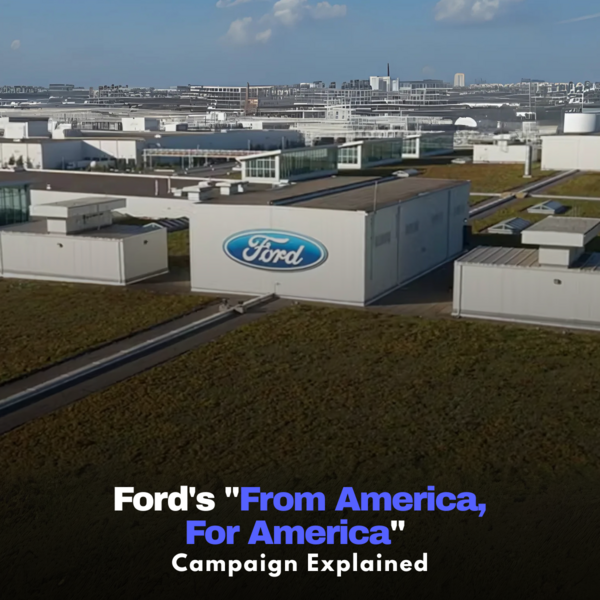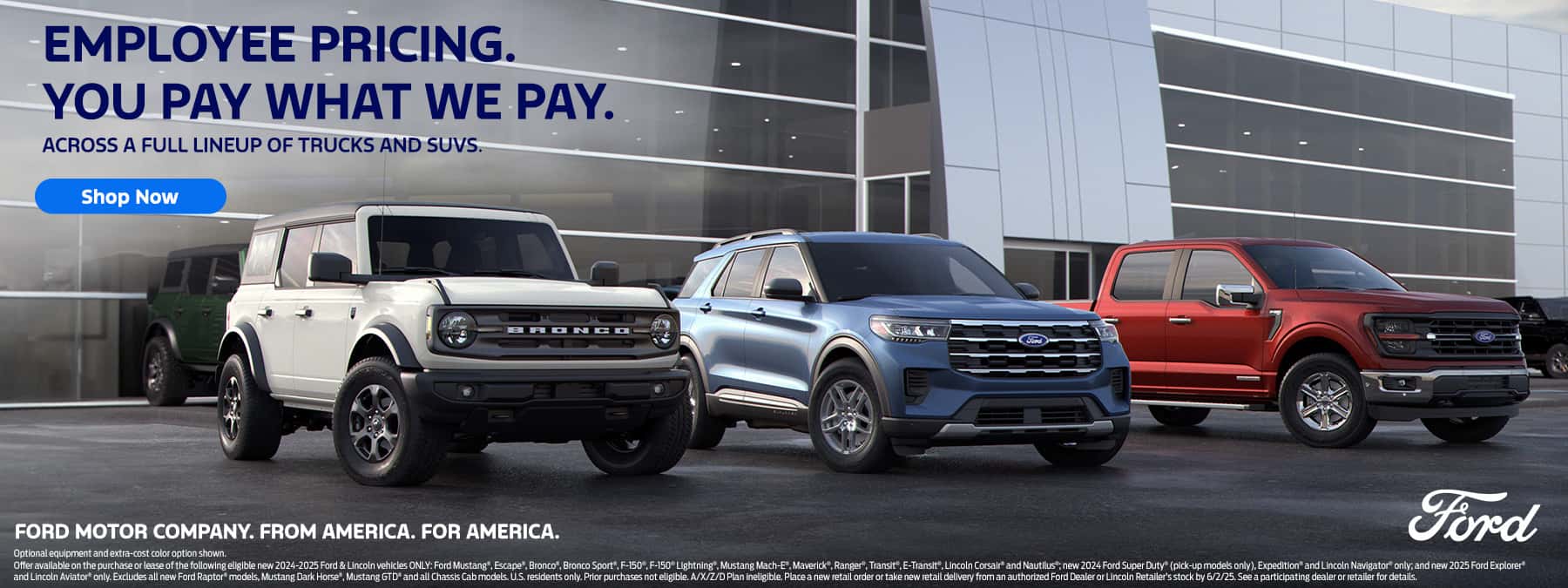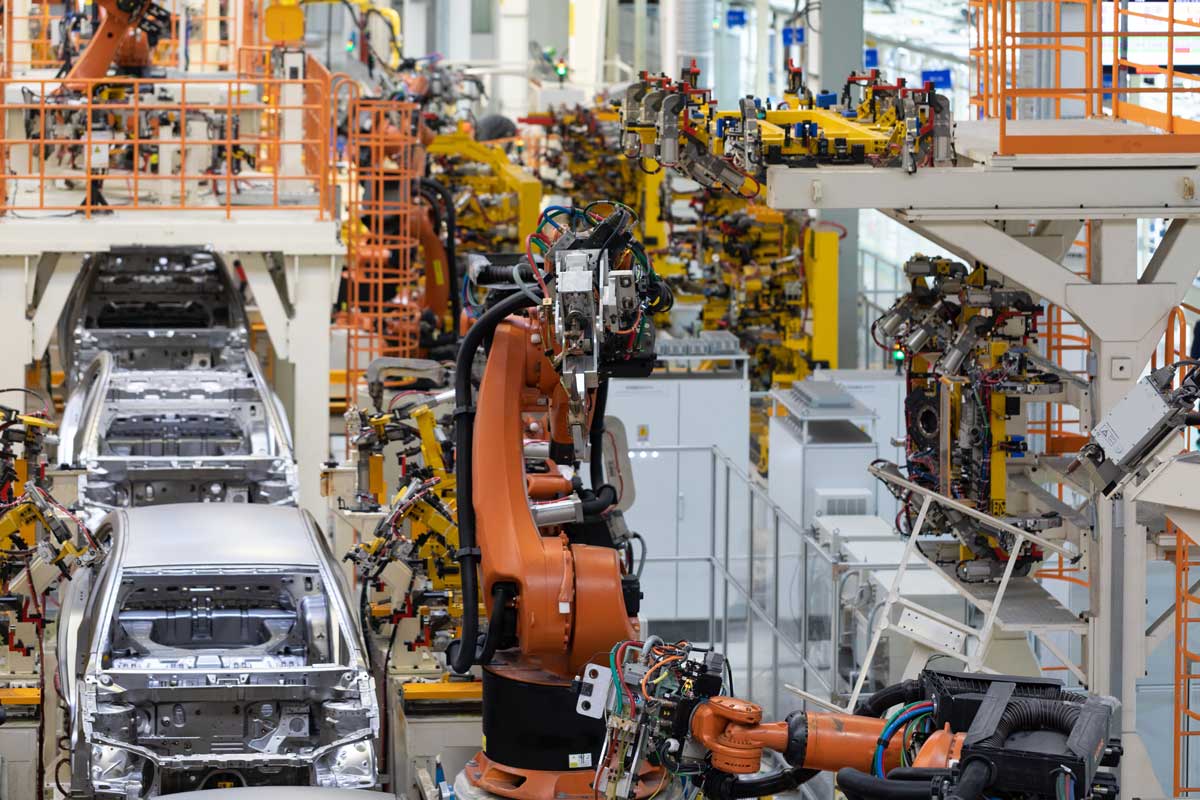
“From America, For America” - Ford’s Bold Pricing Gambit Tests the Limits of Tariff-Era Auto Economics
“From America, For America”: Ford’s Bold Pricing Gambit Tests the Limits of Tariff-Era Auto Economics
As Trump’s Tariffs Redraw Industry Boundaries, Ford Bets on Patriotism, Pricing Power—and Inventory
Dearborn, Mich. — It reads like a throwback to wartime posters: bold, star-spangled, and brimming with promise. “From America, For America,” proclaims Ford Motor Company in its latest campaign—part defiant stance, part marketing juggernaut. But behind the patriotic veneer lies a highly calculated strategy: an all-out bid to get ahead of the tectonic shifts now threatening to upend the U.S. auto industry.

Launched just days after President Trump enacted sweeping 25% tariffs on imported cars and auto parts, Ford’s campaign extends its coveted employee pricing—typically reserved for insiders—to the general public. Running from April 3 to June 2, the promotion is being hailed by some as a masterstroke in inventory management and branding. Others see it as a thinly veiled scramble to dump excess supply before the tariff hammer falls hardest.
With nearly 80% of its U.S.-sold vehicles already manufactured domestically, Ford is trying to turn its domestic footprint into a competitive moat. But beneath the surface, this pricing blitz is less about celebration and more about insulation—from rising costs, supply chain shocks, and a market grappling with a new geopolitical reality.
A High-Stakes Play in a Disrupted Market
Ford’s offer taps into its A-Plan pricing, effectively selling vehicles to consumers at employee-level discounts—typically below dealer invoice. It applies to most 2024 and 2025 Ford and Lincoln models, excluding heavy-duty or specialty vehicles like the F-150 Raptor and Super Duty trucks. The campaign also sweetens the deal for EV buyers: free home chargers and installation through June 30, bundled under the company’s “Power Promise.”

The timing is no coincidence. The new tariffs, widely expected but still jarring in scope, have thrown automakers into defensive crouches. Every bolt, circuit board, and seatbelt sourced abroad now carries an inflated price tag. For Ford, which holds a relatively deep 74-day inventory—versus GM and Toyota’s leaner stocks—this is a moment to act.
Comparison of US vehicle inventory days' supply for major automakers like Ford, GM, and Toyota.
| Manufacturer | Days' Supply | As of Date/Period | Source(s) |
|---|---|---|---|
| Toyota | 30 | End of Feb 2025 | MarkLines (reporting on U.S. media figures) |
| Ford | 127 | December 2023 | CarEdge |
| Ford | 141 (F-150) | Start of Feb 2025 | Cox Automotive (reporting vAuto Live Market View) |
| GM (Overall) | ~93 (Chev.) | April 2025 | CarEdge |
| GM (Chev.) | 70 (Silv.) | Start of Aug 2024 | Cox Automotive (reporting vAuto Live Market View) |
| Toyota | 36 | Start of Feb 2024 | Cox Automotive (reporting vAuto Live Market View) |
| Ford | --- | Start of Feb 2024 | Cox Automotive (Not explicitly stated, but implied high)* |
| GM (Overall) | --- | Start of Feb 2024 | Cox Automotive (Not explicitly stated)* |
| Toyota | 41 | December 2023 | CarEdge |
| Chevrolet | 88 | December 2023 | CarEdge |
“This is about buffering volatility before it hits the showroom,” said one Detroit-based analyst. “Ford’s trying to lock in demand while it still controls pricing. Once suppliers start passing costs up the chain, this flexibility evaporates.”
Tariffs are taxes governments place on imported goods, like cars or car parts. These taxes increase the cost of importing those goods, which can subsequently raise the final price consumers pay for automobiles.
The Patriot’s Discount: Powerful Optics or Tactical Smokescreen?
Ford’s messaging is heavy with Americana. In TV spots and social media pushes, the company portrays itself as a bulwark of American industry—employing U.S. workers, building in U.S. plants, and standing by American consumers during economic turbulence.

Adweek praised the campaign’s clear alignment with public sentiment, especially in the wake of increasingly protectionist policy. “It’s a handshake deal with every American,” Ford claims—a phrase that now echoes across dealership banners and primetime ad slots.
But not everyone is buying the altruism.
“It’s not a handshake, it’s a soft push,” quipped one seasoned automotive consultant. “Ford has inventory to move and a margin window that’s closing. This is a tactical blitz disguised as a patriotic appeal.”
Critics point out that the campaign may be less about shielding consumers from future price hikes, and more about front-loading sales while Ford’s cost base still reflects pre-tariff conditions. Some worry this sends a signal of weakness to investors—suggesting Ford may be anticipating margin compression ahead.
“Employee Pricing” Meets Main Street Scrutiny
While the headline “employee pricing for everyone” sounds generous, buyers are approaching the offer with guarded optimism. On popular forums like Reddit’s r/cars and Ford enthusiast sites, threads dissect invoice numbers, dealer tactics, and fine print.
MSRP (Manufacturer's Suggested Retail Price) is the sticker price recommended by the carmaker, while the invoice price is theoretically what the dealership paid for the vehicle. Understanding the difference between these figures is key for negotiation, as buyers often aim for a final price closer to or sometimes even below the invoice price, factoring in potential dealer incentives.
One user summarized the mood bluntly: “If you’re not shopping smart, this ‘deal’ is just moving numbers around.”
Many posts highlight that the employee discount often translates to only about 4–4.5% below invoice—amounting to roughly $2,500 on a $55,000 vehicle. For some, that’s barely better than a hard-fought negotiation. Others complain of dealer markups, opaque financing structures, and hidden fees that erode the advertised savings.
But savvy shoppers do report wins. “I got a better rate by driving two states over,” wrote one user who managed to combine employee pricing with aggressive dealer rebates. Still, most agree that the real value lies in legwork, not slogans.
Short-Term Stability, Long-Term Uncertainty
The auto industry is no stranger to promotions, but the stakes this time are higher. The 25% tariff—if sustained—could raise per-vehicle production costs by $5,000 to $15,000, depending on parts origin and assembly geography. Even domestically built vehicles, like many Fords, rely heavily on imported components.
Projected impact of a 25% tariff on average US vehicle prices.
| Vehicle Type/Origin | Estimated Price Increase (%) | Estimated Price Increase ($) | Source/Date (Analysis Period) | Notes |
|---|---|---|---|---|
| Average New Vehicle (Overall) | 13.5% | $6,400 | The Budget Lab (Yale) (2025) | Based on average 2024 new car price of ~$48,000. |
| Average New Vehicle (Overall) | 11.4% | N/A | J.P. Morgan Research (2025) | Assumes automakers pass tariff-related costs to consumers. |
| Imported Models | 31% | N/A | The Budget Lab (Yale) (2025) | Significantly higher impact than the overall average. |
| Average New Vehicle (Overall) | N/A | $5,300 | Cox Automotive (2025) | Refers to models facing 25% tariffs at the border; these made up 13% of US sales in the previous year. |
| Average New Vehicle (Overall) | N/A | $5,000 - $10,000 | Wedbush Securities (2025) | "Out of the gates" estimate due to tariffs on vehicles and parts. |
| Vehicles Subject to 25% Tariff | 15-20% | N/A | Cox Automotive (2025) | Estimate for vehicles directly impacted by the tariff. |
| Vehicles Exempt from 25% Tariff (e.g., US-made) | ~5% | N/A | Cox Automotive (2025) | Anticipated price increase even for exempt vehicles as automakers spread costs. |
| Vehicles Priced Under $30,000 | N/A | N/A | Cox Automotive (2025) | Particularly vulnerable; analysis suggests 25% tariff applies to nearly 80% of vehicles in this price range. |
| Luxury Sedans/SUVs (Imported) | N/A | Up to $20,000 | Anderson Economic Group (2025) | Brands like Audi, BMW, Jaguar-Land Rover, Mercedes-Benz, Genesis, Lexus expected to be hardest hit. |
Ford’s current move may delay the price reckoning, but it cannot prevent it. Analysts from Business Insider to the Economic Times warn that once stockpiles shrink and tariff-inflated supply chains take hold, price hikes will be inevitable.
“The real question isn’t what cars cost in April,” said one automotive economist. “It’s what they’ll cost in December.”
Competitive Pressure Mounts Across the Sector
By moving first, Ford has effectively challenged competitors to match its consumer concessions—or risk appearing tone-deaf to economic anxiety. GM and Stellantis, both of which have higher exposure to international supply chains, now face tough strategic choices. Matching Ford’s pricing could erode their already strained margins; refusing to do so risks market share.
For suppliers and dealers, the campaign is a double-edged sword. It might temporarily boost volumes, but it also tightens profit margins and raises questions about pricing integrity. If buyers expect “employee pricing” to become the new normal, that could reshape dealership economics well beyond June.
Investors Eye a Reshaped Auto Future
For professional investors and auto equity analysts, Ford’s campaign is both signal and symptom.
Signal: The company is playing defense early, perhaps wisely, anticipating a turbulent second half of 2025 as tariff effects deepen.
Symptom: The underlying stress on input costs, margin pressure, and global supply chain reconfiguration is now too large to ignore. Analysts expect more automakers to follow suit—perhaps with their own campaigns, but also with deeper investments in U.S.-based manufacturing, cost-cutting programs, or price-tier reshuffles.
Auto manufacturer (OEM) valuations are determined using key financial metrics like earnings multiples and revenue growth. These valuations are also heavily influenced by factors such as profitability, technological innovation (especially in EVs), competitive positioning, and broader economic conditions affecting the auto industry.
“If this pricing trend sticks, we could see a full-scale repricing of OEM valuations,” said one institutional investor. “Legacy automakers that don’t adapt fast enough could become structurally disadvantaged.”
What Comes Next: Bold Predictions in a Fragile Market
1. The Reshoring Race Begins
Industry observers expect a new wave of U.S. investment in parts manufacturing, aimed at dodging tariffs long-term. This reshoring process will be expensive, slow, and fraught with execution risk—but necessary. Some experts forecast billions in new CAPEX flowing into the Midwest and South by 2026.

2. Used Cars, EVs, and Alternatives Gain Ground
As sticker prices climb, consumers may increasingly turn to used vehicles, leasing, or even ride-sharing to manage costs. This could crimp new vehicle demand—particularly in the midsize SUV and luxury sedan segments—and push more capital into EV startups or mobility platforms.
Trend comparison of New vs. Used car sales volume in the US over recent years.
| Year | New Car Sales (Millions) | Used Car Sales (Millions) - Cox Auto Estimate | Used Car Sales (Millions) - Dealership Only (Carscoops/Cox) | Used-to-New Ratio (Based on Cox Auto Total Used Estimate) |
|---|---|---|---|---|
| 2022 | ~13.6 - 13.9 | ~36.3 - 38.6 | ~16.9 | ~2.6 : 1 to ~2.8 : 1 |
| 2023 | ~15.6 | ~35.9 | ~16.2 | ~2.3 : 1 |
| 2024 | ~15.85 - 16.0 | ~37.4 (Forecast) | ~16.9 | ~2.3 : 1 to ~2.4 : 1 |
| 2025 (Forecast) | ~16.2 - 16.3 | ~37.8 (Forecast) | ~20.1 (Retail Forecast) | ~2.3 : 1 |
3. Tariffs Spur Innovation—Under Duress
Necessity may mother invention. Tariff-induced pain could accelerate innovation in modular vehicle architecture, lightweight materials, and localized final assembly—all aimed at minimizing exposure to international supply chains. Automakers who succeed here could leapfrog rivals still dependent on old cost structures.
A Campaign That Looks Backward and Forward at Once
Ford’s “From America, For America” campaign draws strength from nostalgia—an era of Detroit dominance, flag-waving optimism, and straightforward patriotism. But its true function is thoroughly modern: to serve as a stopgap against macroeconomic headwinds that could redefine the auto landscape.
It may buy Ford time. It may win over budget-conscious consumers. But it also raises tough questions—for the industry, for investors, and for policymakers—about whether America’s auto sector is truly ready for the new age of economic nationalism.
The sticker might say “employee pricing,” but the real cost of this transition is still being tallied.